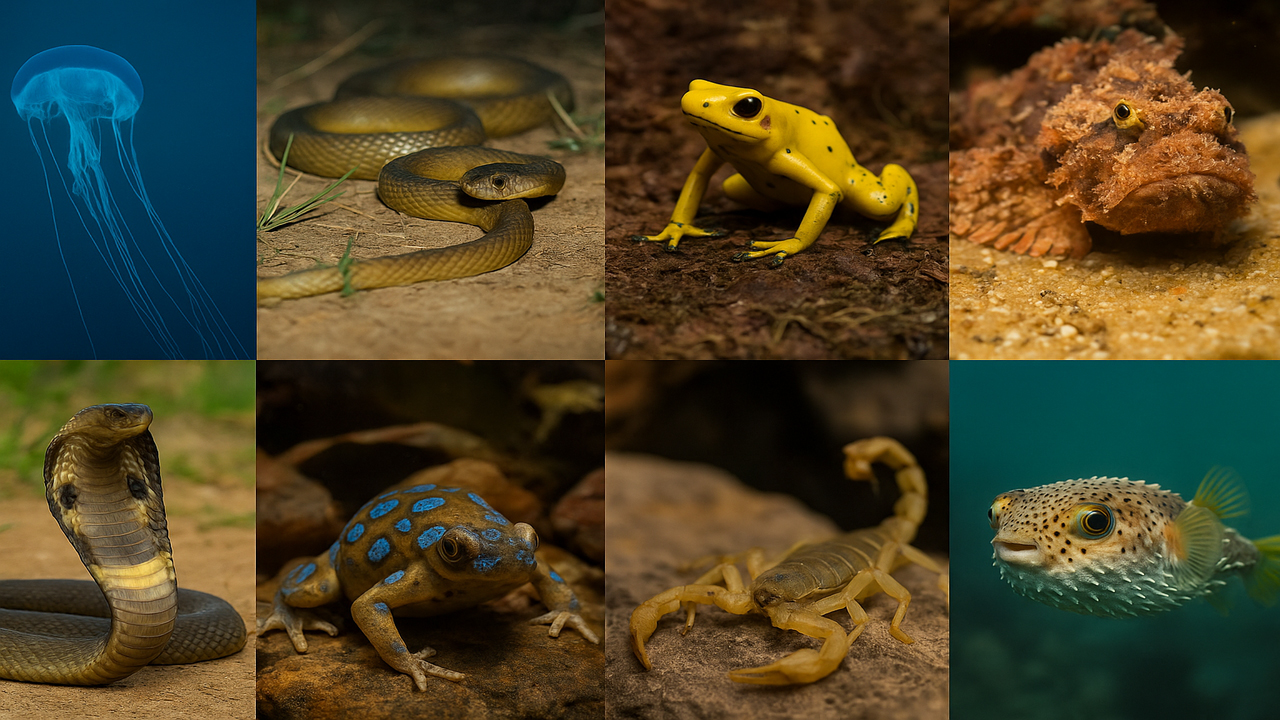
Top 10 most Dangerous Wild Animals in the World that have Deadly Poison
Top Ten Things – Top 10 most Dangerous Wild Animals in the World that have Deadly Poison
Wild animals possess incredible survival traits, but some are dangerously equipped with potent poison.
Understanding which species are the most hazardous can help us appreciate their power while respecting their habitats.
Today, we will explore the top 10 most dangerous wild animals that are known for their deadly poison, based on insights from Top Ten Things and other wildlife experts.
The box jellyfish, found mostly in the waters of Australia and Southeast Asia, is incredibly dangerous.
Its tentacles contain toxins that attack the heart, nervous system, and skin cells almost immediately.
Some victims experience cardiac arrest before reaching the shore, highlighting why this creature ranks high among dangerous wild animals.
According to Top Ten Things, even a small encounter with this jellyfish can be fatal without rapid treatment.
“Read more : Top 10 Types of Short-Haired Cat Breeds in the World, Animals Cat Lovers“
Known as the “fierce snake,” the Inland Taipan possesses the most toxic venom of any land snake.
One bite contains enough poison to kill 100 adult humans within 45 minutes if untreated.
Fortunately, this snake is extremely shy and rarely confronts humans.
Still, it remains one of the most dangerous wild animals in the world.
Despite their small size, poison dart frogs pack a deadly punch through their skin secretions.
Found mainly in Central and South America, these colorful frogs have toxins strong enough to kill 10 adult humans.
Local tribes even use their poison to tip hunting darts, which inspired the frog’s infamous name.
Top Ten Things notes that the bright colors serve as a natural warning for predators.
Stonefish are masters of camouflage, blending seamlessly with ocean floors.
When stepped on, they deliver venom through sharp dorsal spines, causing excruciating pain, paralysis, and even death.
Swimmers and divers must exercise extreme caution in shallow waters where stonefish are often hidden.
The king cobra, the longest venomous snake on Earth, can grow up to 18 feet long.
Its venom attacks the victim’s nervous system, causing blurred vision, vertigo, and eventually respiratory failure.
Despite its fearsome reputation, the king cobra prefers to avoid humans and only strikes when threatened.
This small but deadly octopus carries enough venom to kill 26 adult humans within minutes.
Its bites are often painless but lead to severe paralysis and respiratory arrest if untreated.
Identifiable by its vivid blue rings, this creature resides in tidal pools and coral reefs in the Pacific and Indian Oceans.
“Read more : 6 Morning Habits to Lose Weight, Healthy Tips for Dieting“
The Brazilian wandering spider is considered one of the most venomous spiders in the world.
Its venom can cause intense pain, muscle paralysis, and breathing difficulties in severe cases.
Found mostly in South America, this spider is highly aggressive and often hides in homes, clothing, and cars.
Do not be fooled by the beautiful patterns on cone snails.
Their harpoon-like tooth can deliver a potent neurotoxin that paralyzes prey instantly.
Some species have venom powerful enough to kill humans, and there is no antivenom currently available.
Top Ten Things warns that victims often feel no pain until the symptoms become critical.
The deathstalker scorpion, found in desert regions across North Africa and the Middle East, has venom that causes severe pain.
Its sting can be fatal, especially for children and those with weak immune systems.
Despite their danger, deathstalker scorpions are also studied for their unique toxins, which show promise in cancer research.
While pufferfish are famous for their ability to inflate when threatened, they are also extremely poisonous.
Their organs contain tetrodotoxin, a chemical 1,200 times more toxic than cyanide.
One pufferfish holds enough poison to kill 30 adult humans, making it one of the deadliest marine animals.
Although these animals are dangerous, they play critical roles in their ecosystems.
Understanding and respecting their power allows humans to coexist safely with these fascinating creatures.
Top Ten Things reminds us that most wildlife incidents occur because humans venture too close or fail to recognize warning signs.
By learning about dangerous wild animals, we not only protect ourselves but also support conservation efforts to preserve biodiversity.
Whether it is a snake in the desert or a jellyfish in the ocean, every creature deserves our caution and respect.